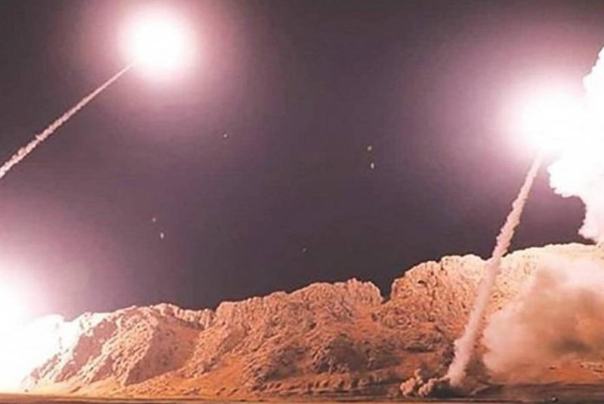
Iran launch missiles targeting U.S. forces on Al Asad Airbase, Iraq, to avenge the death of General Qassem Soleimani, 8 January 2020.
“This goal [to expel American forces] will be pursued until the result is achieved.”
In the early morning hours of 3 January 2020, a U.S. drone strike killed both Islamic Revolutionary Guard Corps (IRGC) Quds Force chief Qasem Soleimani and Abu Mahdi al-Muhandis, the deputy chief of Iraq’s Popular Mobilization Forces (al-hashd al-shaabi) on the outskirts of Baghdad International Airport.[i] Five days later, the IRGC retaliated with Operation Martyr Soleimani, consisting of about a dozen missiles fired at Ayn al-Assad Air Base in Iraq’s western al-Anbar Governorate and Erbil International Airport in Iraqi Kurdistan.[ii] Both are Iraqi facilities where U.S. forces are present. While no American personnel were killed, more than 100 U.S. military personnel were injured in the strike. As the accompanying article describes, over three years later, Soleimani’s death continues to resonate in Iran, with major Iranian military figures calling for the expulsion of the United States from the region.
The excerpted statement from Mohammad Bagheri, an IRGC general who has, since June 2016, served as Chief of Staff of the Iranian Armed Forces, expresses outrage at the death of Soleimani. As he writes in the below, Operation Martyr Soleimani was “the beginning of the work…of the Islamic Republic of Iran and the axis of resistance to fulfill the efforts of Martyr Haj Qasem to expel American terrorist forces from the region.”Bagheri’s likening of the Iranian retaliation against supposed U.S. planners at Ayn al-Assad Air Base to the Japanese attack on Pearl Harbor suggests, at least in the IRGC’s mindset, that Iran is at war with the United States. Also notable is that the reformist news outlet Shargh Daily published this piece, as it underscores how, even across Iran’s divided political spectrum, Soleimani’s death remains resonant.
Source:
“Payam Sarlashkar Bagheri beh Monasabat-e Shahid Soleimani ‘Amaliyat-e (General Bagheri’s Message on the Anniversary of the Martyr Soleimani Operation),” Shargh Daily (website of one of Iran’s more popular reformist newspapers), 7 January 2023. https://www.sharghdaily.com/بخش-سیاست-6/866489-پیام-سرلشکر-باقری-به-مناسبت-عملیات-شهید-سلیمانی
On the morning of 3 January 2020, the terrorist U.S. government killed Lt.-Gen. Haj Qasem Soleimani, the national hero and the Muslim world, and a group of commanders and comrades of the resistance front at Baghdad Airport with a drone strike. This act of terrorism left the Iranian nation, Islamic nations and other nations of the world perplexed as to how a government had been able to target with a drone strike an official guest of the Iraqi government contrary to all legal, political and international rules!
It was obvious that under such circumstances and the martyrdom of the master of the martyrs, the first demand not only of the Iranian people but also the rightful nations was to confront the U.S. terrorist act, but also the rightful nations. The Armed Forces of the Islamic Republic of Iran, realizing this demand prepared to bomb and destroy the U.S. base of ‘Ayn al-Assad on Iraqi soil, which was known as one of the bases where the United States plotting the assassination of General Soleimani. Therefore, on the morning of 8 January 2020, the IRGC’s aerospace force fired 13 ballistic missiles to inflict a hard slap against the terror planning and execution center in the first countermeasure and an action that was unprecedented in the past 70 years and it was able to destroy America’s hegemony in the region and the world. Of course, this operation was the beginning of the work and the strategy of the Islamic Republic of Iran and the axis of resistance to fulfill the efforts of Martyr Haj Qasem to expel American terrorist forces from the region. This goal will be pursued until the result is achieved.
Notes:
[i] For a brief overview of both Qasem Soleimani and Abu Mahdi al-Muhandis, see: Nectar Gan, “Who was Qasem Soleimani, the Iranian commander killed by a US airstrike?” CNN.com, 3 July 2020. https://edition.cnn.com/2020/01/03/asia/soleimani-profile-intl-hnk/index.html
[ii] For an American account of the Iranian attack on Ayn al-Assad Air Base, see: David Martin and Mary Walsh, “Who would live and who would die: The inside story of the Iranian attack on Al Asad Airbase,” CBS News, 8 August 2021. https://www.cbsnews.com/news/iranian-attack-al-asad-air-base-60-minutes-2021-08-08/
Image Information:
Image: Iran launch missiles targeting U.S. forces on Al Asad Airbase, Iraq, to avenge the death of General Qassem Soleimani, 8 January 2020
Source: https://nournews.ir/Media/photo/20/01/20011101000958_org.jpg
Attribution: NourNews.ir
